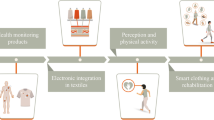Abstract
Protection and aesthetics are the two common dimensions or attributes typically associated with textiles as clothing. However, with the rapidly changing needs of today’s consumers, a third dimension is emerging—that of “intelligence”—that is being integrated into fabrics to produce interactive textiles, or i-textiles. This new class of wearable electronic systems is being designed to meet new and innovative applications in the military, public safety, healthcare, space exploration, sports, and consumer fitness fields. In this article, the concept of i-textiles is presented, along with the building blocks for its realization. This is followed by an overview of the design and development of the Smart Shirt, an “intelligent” garment that provides an extremely versatile framework for the incorporation of sensing, monitoring, and information-processing devices. The key applications of the Smart Shirt technology and their impact in transforming healthcare are discussed. Finally, the need to advance this paradigm and identify opportunities to transform passive textiles into the new generation of interactive, or “smart,” textiles is discussed.
Similar content being viewed by others
References
C. Gopalsamy, S. Park, R. Rajamanickam, and S. Jayaraman, J. Virtual Reality 4 ( 1999) p. 152.
The Georgia Tech Wearable Motherboard™: The Intelligent Garment for the 21st Century, http://www.smartshirt.gatech.edu (accessed April 2003).
S. Park, and S. Jayaraman, in Smart Fibers, Fabrics and Clothing: Fundamentals and Applications, edited by X. Tao (Woodhead Publishing, Cambridge, UK, 2001) p. 226.
DARPA BAA on Electronic Textiles, http://www.darpa.mil/baa/BAA01-41.htm (accessed April 2003).
SOFTswitch, http://www.softswitch.co.uk (accessed April 2003).
“Musical Jacket Project,” www.media.mit.edu (accessed April 2003).
E.R. Post, M. Orth, P.R. Russo, and N. Gershenfeld, IBM Sys. J. 39 (3&4) ( 2000) p. 840.
“Infineon’s MP3 Player,” http://www.siliconstrategies.com/story/OEG20020426S0101 (accessed April 2003).
Y. Akao, S. Ono, A. Harada, H. Tanaka, and K. Iwasaka, Quality 13 (3) ( 1983) p. 61
Y. Akao, ed. Quality Function Deployment (Productivity Press, Cambridge, MA 1990).
R. Rajamanickam, S. Park, and S. Jayaraman, J. Textile Inst. 89 (3) ( 1998) p. 44.
M. Kitazawa, J.F. Kreidl, and R.E. Steele, eds., in Proc. SPIE Plastic Optical Fibers, Vol. 1592 (SPIE—The International Society for Optical Engineering, Bellingham, WA, 1991).
Y. Chai, Handbook of Fiber Optics: Theory and Applications (Academic Press, New York, 1990).
S. Park, C. Gopalsamy, R. Rajamanickam, and S. Jayaraman, Studies in Health Technology and Informatics, Vol. 62 (IOS Press, Amsterdam, 1999) p. 252.
S. Park, and S. Jayaraman, Atlanta Med. 74 (4) ( 2001) p. 24.
S. Jayaraman, J. Textile Inst. 81 (2) ( 1990) p. 185.
Rights and permissions
About this article
Cite this article
Park, S., Jayaraman, S. Smart Textiles: Wearable Electronic Systems. MRS Bulletin 28, 585–591 (2003). https://doi.org/10.1557/mrs2003.170
Published:
Issue Date:
DOI: https://doi.org/10.1557/mrs2003.170




